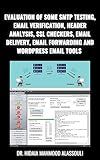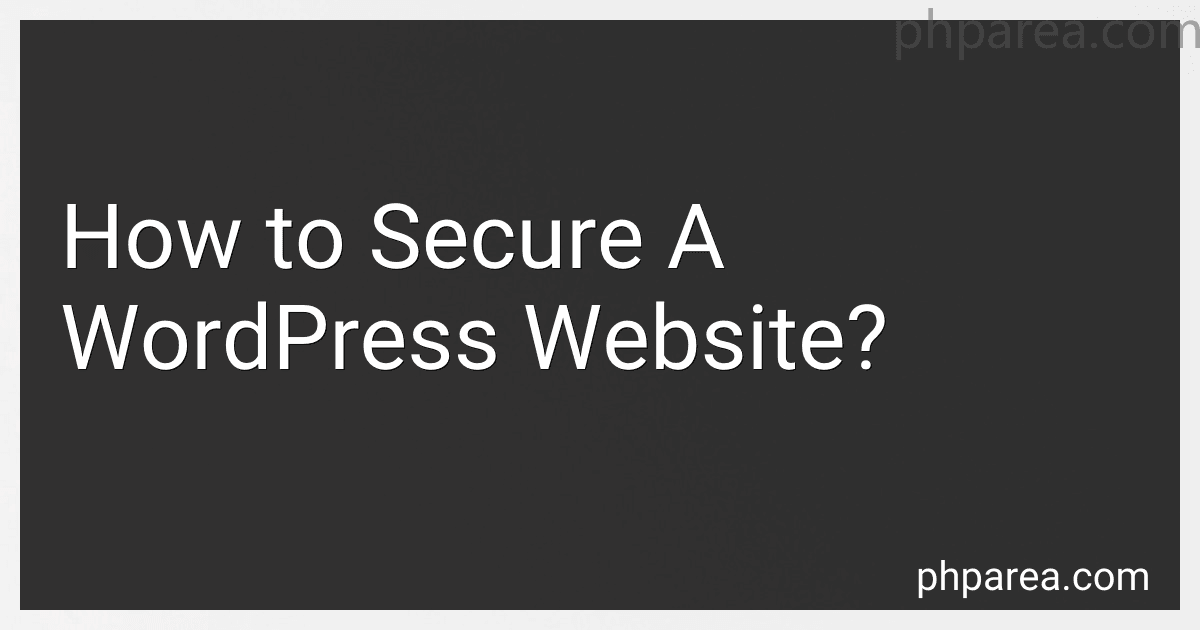Best WordPress Security Solutions to Buy in December 2025

Evaluation of Some SMTP Testing, Email Verification, Header Analysis, SSL Checkers, Email Delivery, Email Forwarding and WordPress Email Tools



WordPress for Beginners 2019: A Visual Step-by-Step Guide to Mastering WordPress (Webmaster Series)



WordPress GUIDE COMPLET Simple et Efficace: English Edition-Complete Guide (DigitalMarket)


Securing a WordPress website is crucial to protect it from potential threats and ensure its smooth operation. Here are some essential measures to consider:
- Use strong login credentials: Create a unique and complex username and password for your WordPress admin account. Avoid using common usernames like "admin" or simple passwords.
- Update WordPress regularly: Ensure that your WordPress installation, themes, and plugins are up to date. Developers often release updates that fix security vulnerabilities, so maintaining the latest versions is crucial.
- Choose reliable themes and plugins: Only install themes and plugins from trusted sources, such as the official WordPress repository. Read reviews and ratings before installing any new theme or plugin to ensure they are secure.
- Limit login attempts: Implement a login limit plugin or use features provided by security plugins to restrict the number of login attempts. This makes it harder for attackers to guess login credentials through brute-force attacks.
- Enable two-factor authentication (2FA): Enable 2FA for your WordPress admin account. This adds an extra layer of security by requiring a verification code in addition to the regular login credentials.
- Regularly backup your website: Backup your WordPress website and its database regularly. In case of a security breach or any other issue, having a recent backup ensures that you can restore your website quickly.
- Protect the wp-admin directory: Restrict access to the wp-admin directory by modifying the .htaccess file or using security plugins. This prevents unauthorized users from accessing sensitive areas of your website.
- Secure your wp-config.php file: The wp-config.php file contains essential information such as database credentials. Protect it by moving it to a directory outside the web server's root and set proper file permissions (e.g., read-only).
- Install a security plugin: Utilize WordPress security plugins such as Wordfence, Sucuri Security, or iThemes Security. These plugins offer a wide range of features and configurations to enhance your website's security.
- Regularly scan for malware and vulnerabilities: Use security plugins to scan your website for malware, suspicious files, and vulnerabilities. These scans can help you identify and address potential security issues proactively.
Implementing these security measures significantly enhances the security of your WordPress website and helps protect it from various threats that could compromise its stability and data.
What are the dangers of using insecure or outdated WordPress themes?
Using insecure or outdated WordPress themes can pose several dangers, including:
- Security vulnerabilities: Insecure or outdated themes may have known security flaws or weak code, making it easier for hackers to exploit the website. This can lead to unauthorized access, data breaches, defacement, or installation of malicious scripts.
- Malware or virus infections: Themes obtained from untrustworthy sources may contain hidden malware or viruses that can infect the website and potentially spread to visitor's devices. This can result in personal information theft, spam distribution, or even blacklisting by search engines.
- Lack of compatibility: Outdated themes may not be compatible with the latest versions of WordPress and its plugins. This can cause errors, conflicts, or even break the functionality of the website, negatively impacting user experience and search engine rankings.
- Poor performance: Inefficient or poorly-coded themes can slow down the loading speed of a website, leading to a frustrating user experience. This can result in higher bounce rates, lower search engine rankings, and reduced traffic.
- Missing out on new features: Outdated themes may lack the latest features, improvements, or optimizations available in new versions. This can prevent website owners from utilizing enhancements in design, functionality, or user engagement, potentially hampering their competitiveness.
- Limited support and updates: Insecure or outdated themes may not receive regular updates or support from the developers. This means that any issues or vulnerabilities discovered may not be addressed promptly, leaving the website exposed to risks over time.
To mitigate these dangers, it is crucial to regularly update WordPress themes, use themes from reputable sources, maintain an active support system, and stay informed about security best practices.
What is the significance of securing the wp-config.php file in WordPress?
Securing the wp-config.php file in WordPress is crucial for maintaining the security and integrity of a WordPress website. The wp-config.php file contains important configuration settings and sensitive information, including database credentials, authentication keys, and salts.
Here are some reasons why it is significant to secure the wp-config.php file:
- Database Protection: The wp-config.php file holds the database connection details, including the username and password. If an unauthorized person gains access to this file, they can potentially gain control over the entire database, leading to data breaches, manipulation, or loss.
- Authentication and Authorization: The file contains authentication keys and salts, which are used for encrypting user session data and passwords. If these keys are compromised, it can potentially facilitate unauthorized access to user accounts and weaken overall system security.
- Site Security: The wp-config.php file's security is directly related to the overall security of the WordPress site. By safeguarding this file, website owners can reduce the risks of unauthorized access, hacking attempts, and other security exploits.
- Malware Prevention: Since the wp-config.php file is crucial for the functioning of a WordPress site, hackers may attempt to inject malicious code into it. By securing the file, website owners can protect their site from malware, malicious scripts, and other forms of cyber threats.
To secure the wp-config.php file, some recommended practices include:
a. Changing File Permissions: Set the file permissions to 400 (read-only for the owner) so that only the server can access the file.
b. Moving the File: Move the wp-config.php file out of the web-accessible directory (i.e., the root directory) to a higher level or a non-public location where it can't be directly accessed by visitors or unauthorized individuals.
c. Using .htaccess: Set up additional security measures by modifying the .htaccess file, allowing access to the wp-config.php file only from specific IP addresses.
d. Regular Backups: Ensure regular backups of the wp-config.php file, so that in case of any issues or compromises, it can be restored easily.
By implementing these security measures, website owners can protect the wp-config.php file, reducing the risks associated with potential data breaches, unauthorized access, and system vulnerabilities.
How to schedule automatic backups for a WordPress website?
To schedule automatic backups for a WordPress website, you can follow these steps:
- Use a backup plugin: Install and activate a reliable backup plugin on your WordPress website. Some popular options include UpdraftPlus, BackUpBuddy, or VaultPress.
- Configure plugin settings: Once the plugin is activated, go to its settings page. Configure the backup settings to your desired specifications, such as the backup frequency, backup location (local or remote), and types of files and database tables to include in the backup.
- Choose a backup storage destination: Select where you want to store the backups. You can choose options like local server storage, remote storage services like Dropbox, Google Drive, or an FTP server. Ensure you have appropriate credentials or access to the storage destination.
- Set backup frequency: Determine how often you want backups to occur. It's recommended to schedule daily or weekly backups, depending on the content update frequency and importance of your website.
- Enable automatic backups: Enable the automatic backup feature in the plugin settings. This feature ensures that backups will be executed automatically based on the chosen frequency.
- Test backup functionality: Before relying solely on automated backups, manually initiate a backup to ensure it runs smoothly and completes successfully. Verify that the backup files are stored in the specified location.
- Monitor backups: Regularly check the backup logs or email notifications provided by the plugin to confirm that backups are occurring as scheduled. It's essential to monitor backups to ensure the process is functioning correctly.
Remember to regularly review and update your backup solution to ensure it continues to meet your requirements. Having automated backups in place is crucial for website security and protection against data loss.
What are the best security plugins for WordPress websites?
There are several great security plugins available for WordPress websites. Here are some popular ones:
- Wordfence Security: Wordfence is one of the most comprehensive security plugins, offering firewall protection, malware scanning, login security, and more.
- Sucuri Security: Sucuri is known for its robust website security services. Their plugin offers features like security auditing, malware scanning, blacklist monitoring, and website firewall.
- iThemes Security: iThemes is a powerful security plugin that provides features such as two-factor authentication, brute force protection, file change detection, database backups, and more.
- All In One WP Security & Firewall: This plugin offers advanced firewall protection, login lockdown, spam prevention, and database security measures.
- BulletProof Security: BulletProof Security provides protection against brute force attacks, malware scanning, file monitoring, and a built-in firewall.
- MalCare Security: MalCare offers real-time malware scanning, removal, and firewall protection. It also provides features like website management, backups, and login protection.
Remember that no plugin can guarantee 100% security, and it's important to follow other security best practices, such as keeping your WordPress version and plugins/themes up to date, using strong passwords, and regularly backing up your website.
What are the risks of using outdated themes and plugins in WordPress?
Using outdated themes and plugins in WordPress poses several risks, including:
- Security vulnerabilities: Outdated themes and plugins may have security flaws or vulnerabilities that could be exploited by hackers. This can lead to various security breaches, such as unauthorized access to sensitive data or injecting malicious code into your website.
- Compatibility issues: Incompatible themes and plugins may not work properly with the latest version of WordPress or other plugins, potentially causing functionality issues or conflicts. This can result in broken features, site errors, or even a complete website crash.
- Performance degradation: Outdated themes and plugins may not be optimized for speed or performance improvements, leading to a slow-loading website. This can negatively impact user experience and search engine rankings.
- Lack of new features and improvements: Outdated themes and plugins won't receive updates or new features introduced in newer versions. Consequently, you may miss out on important functionality enhancements, bug fixes, or new customization options.
- Lack of support and documentation: Themes and plugins that are no longer maintained or updated may lack proper support channels or documentation. In case you encounter issues or need assistance, it may be challenging to find reliable help.
To mitigate these risks, it's crucial to regularly update themes and plugins to their latest versions and verify their compatibility with your WordPress version. Additionally, it is recommended to choose themes and plugins from reputable developers who actively update and support their products.
How to change the default WordPress database table prefix for improved security?
To change the default WordPress database table prefix for improved security, follow these steps:
- Before making any changes, take a complete backup of your WordPress website and database.
- Access your website's files using FTP or a file manager provided by your hosting provider.
- Locate the wp-config.php file in the root directory of your WordPress installation.
- Open the wp-config.php file in a text editor.
- Look for the line that contains the following code:
$table_prefix = 'wp_';
- Change the 'wp_' to a unique and secure prefix of your choice. Make sure to use only letters, numbers, or underscores, without any spaces. For example:
$table_prefix = 'newprefix_';
- Save the changes to the wp-config.php file and close it.
- Now, you need to rename the existing database tables. a. In your WordPress database, locate the tables with the default prefix (wp_). b. Rename each table by replacing the prefix with the new prefix you defined in the wp-config.php file. For example, if you changed the prefix to 'newprefix_', then rename wp_posts to newprefix_posts. Note: Be careful while renaming database tables as it directly affects your website. Ensure you rename every table correctly.
- Once you have renamed all the tables, update the database so that WordPress recognizes the changes. There are two ways to do this: a. Manually update the new prefix in the wp_options table. Look for the option_name called "{$new_prefix}user_roles" and "{$new_prefix}capabilities" and change the option_name field accordingly. Note: Sometimes, the option_name can be 'wp_user_roles' instead of '{$new_prefix}user_roles'. Update it accordingly. b. Use a plugin like "Better Search Replace" to update the database automatically. Install and activate the plugin, then go to Tools -> Better Search Replace. In the "Search for" field, enter the old prefix (wp_), and in the "Replace with" field, enter the new prefix you defined. Select all the tables and click "Run Search/Replace".
- After updating the database and verifying its successful completion, login to your WordPress dashboard and check if everything is functioning properly.
Changing the default WordPress database table prefix adds an extra layer of security to your website, making it more difficult for potential attackers to target your database. Remember to keep your website and plugins up to date regularly, and use strong passwords to further secure your WordPress installation.
How to implement security headers in WordPress for enhanced protection?
To implement security headers in WordPress for enhanced protection, you can follow these steps:
- Install and activate the "HTTP Headers" plugin: Go to your WordPress admin dashboard. Click on "Plugins" in the left menu. Click on "Add New" and search for "HTTP Headers" plugin. Install and activate the plugin.
- Configure security headers: Once the plugin is activated, go to "Settings" and click on "HTTP Headers". You will see a list of available http headers that you can enable or disable. Enable the headers you want to implement for enhanced protection. Common headers include: Strict-Transport-Security (HSTS): Enforces secure HTTPS connections. X-Content-Type-Options: Prevents MIME type sniffing of responses. X-Frame-Options: Prevents clickjacking attacks. X-XSS-Protection: Enables cross-site scripting (XSS) protection. Content-Security-Policy: Defines a policy to protect against content injection attacks. Customize the headers based on your specific needs and security requirements.
- Test the headers and verify their implementation: After configuring the headers, you can test their effectiveness using online tools like securityheaders.com or observatory.mozilla.org. These tools will analyze your website and provide a report on the implementation of security headers. Make sure all desired headers are present and properly configured.
- Regularly update and review security headers: Security headers need to be reviewed periodically as new security threats emerge. Stay up to date with the latest best practices and changes in the WordPress ecosystem. Test and validate the headers after any major updates or changes to ensure continued protection.
Implementing security headers in WordPress can significantly enhance your website's protection against various types of attacks.
